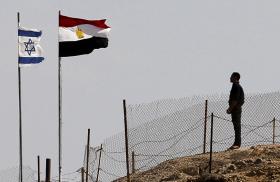
- Policy Analysis
- Articles & Op-Eds
The Biden Administration’s Formula Suggests an Aspiration and a Direction
Also published in Middle East Institute

No one is going to invest in massive Gaza reconstruction unless there is a credible mechanism for ensuring that Hamas does not divert the bulk of this material for military purposes.
The Biden administration has been using a formula to talk about what should exist between Israelis and Palestinians. Here are two peoples in the words of Secretary of State Antony Blinken who should have “equal measures of security, prosperity, democracy, and dignity.” The formula is one that is aspirational because clearly we are far from it today. Certainly, it fits with the objective of producing two states for two peoples, reflecting a conflict that has been about two peoples and two national movements competing for the same space.
Of course, some may embrace this statement as suggesting a one-state outcome in which both peoples enjoy fundamental equality. That objective might work in a laboratory but is an illusion in the Middle East. We are clearly not in a post-nationalism phase in the Middle East (or for that matter internationally), and as we survey the region, the one thing we see is that states that have more than one identity—national, sectarian, or tribal—are either in perpetual conflict, failing, or paralyzed. That is not the future we should seek for Israelis and Palestinians.
Not surprisingly, the Biden administration is committed to a two-state solution, and the formula is designed, at least in part, to suggest an aspiration and a direction. It is also a response to the perception of the Trump administration approach that seemed to focus on Israeli but not Palestinian needs. In that sense, the formula has been offered to project an image of balance.
For the purposes of this discussion, we have been asked to discuss the implications of the formula for the humanitarian situation in Gaza, pending expulsions, and Israeli settlement activities. I find the discussion on Gaza often ahistorical, so a reminder of a few facts is useful. Israel withdrew entirely from Gaza—soldiers and settlers—in 2005. For those who say yes, but they imposed a quarantine on what could go into Gaza, they did not do so until 2007, after the Hamas coup. Hamas never ceased trying to attack Israel after the withdrawal, even carrying out attacks against the crossing points from Israel into Gaza as if they were a favor to Israel. It led the Israelis to reduce the number of crossing points to two, making life more difficult for Gazans, but the well-being of Gazans has rarely been the concern of Hamas.
Consider that after the 2014 conflict between Israel and Hamas that went on for 51 days, Hamas had roughly 3,300 rockets left. The Israelis had destroyed 32 tunnels, of which 14 penetrated Israel. Fast forward to 2021: Hamas had roughly 30,000 rockets, and Israel destroyed about 60 miles of tunnels—which Yahya Sinwar, the Hamas leader in Gaza, said constituted only 5% of the tunnels. Even if an exaggeration, let’s say Israel destroyed half of the tunnel network—a network that is designed not to protect the people of Gaza, but to safeguard the Hamas leaders, fighters, and weapons. Huge amounts of concrete, steel, electrical wiring, and wood went into that underground construction carried out by Hamas—all of which was desperately needed above ground for the development of Gaza.
I am for massive reconstruction of Gaza, not just humanitarian subsistence, and I would like to see the U.S. mobilize the international community to lead the effort. But no one is going to invest in such an effort knowing that Hamas will divert much of this material for its purpose of rearming and rebuilding its underground infrastructure—and also knowing that at a time when Hamas feels it can gain politically in its competition with the Palestinian Authority, it will launch rockets at Israel again, leading to Israeli responses that destroy the investment. So for the sake of the Palestinians in Gaza there needs to be a credible mechanism that can assure reconstruction for no rearmament—and that appears to be the Biden administration approach.
As for the issues of expulsions in Sheikh Jarrah and Israeli settlement activity, two brief comments. First, the Netanyahu government wanted to approach the issue as if it were a narrow legal one. When it comes to Jerusalem, everything is sensitive—and especially when it comes to evictions and displacement. Being right in a narrow technical sense is less important than being wise. And here again the Biden administration—perhaps guided by its formula of equality—has correctly urged a policy of being wise on the Israeli government.
Second, settlement policy should be guided by what preserves a two-state outcome and what puts it at risk. Before we went to Camp David in 2000, we established the concept of settlement blocs and territorial swaps—meaning that Israel would absorb roughly 5% of the territory closest to the June 4, 1967 lines where about 80% of the settlers reside, and the Palestine state would receive territory from Israel as compensation. Building within the bloc areas is consistent with the two-state outcome; building outside is not. Preserving the former is the only way to fulfill the Biden formula.
Dennis Ross is the counselor and William Davidson Distinguished Fellow at The Washington Institute. This article was originally published as part of a debate series on the MEI website.



